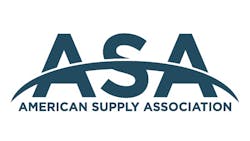American Supply Association Launches Industry-Wide Product Data Standard Project
ITASCA, IL — The American Supply Association (ASA) has announced the launch of the industry’s first Product Data Standard (PDS) Project, a transformative initiative designed to unify how product data is shared across the PHCP and PVF supply chain.
With growing digital demands and operational complexity, ASA is taking a bold step to establish an industry-backed, collaborative standard that will enhance accuracy, efficiency, and innovation for all stakeholders—from manufacturers and distributors to reps.
What Is the PDS Project?
The PDS Project sets out to create a shared framework for product data management, ensuring manufacturers and distributors can exchange consistent, high-quality information. This includes standardizing how critical product attributes such as dimensions, materials, finishes, descriptions, UPCs, and performance data are formatted, maintained, and integrated into business systems.
The standard is being developed in close collaboration with more than 30 leading manufacturers and distributors, supported by ASA’s Embracing the Future Strategic Action Council.
This initiative responds directly to members’ growing frustration with inconsistent spreadsheets, data misinterpretation, and time-consuming, manual cleanup that slows down digital transformation efforts.
“Listening to our members, ASA realized the need for a data standard to make it faster and easier for distributors and manufacturers to get product info from the source to the site in a useful form,” said Jeremy Fuller, Purchasing Manager of Houston-based Texas Plumbing Supply and a key driver of the project, which has featured contributions from about 50 volunteer leaders across ASA-member companies. “In short, we look at every column of data to see if it's needed, relevant, and in the right format for every link in the distribution chain.”
Why Now?
The plumbing and PVF industry is undergoing a rapid shift toward digital. eCommerce, ERP platforms, and digital procurement systems demand structured, reliable product data. Without a shared standard, manufacturers and distributors are forced to build and translate data manually, often with inconsistent results.
ASA recognized this gap during its strategic planning sessions. The lack of a standardized data exchange method was creating delays, errors, and rising costs across the supply chain. As a result, ASA took on the responsibility of developing a unified standard that the entire industry could adopt and benefit from.
With a standardized format in place, product data can move seamlessly from supplier to distributor to end user—reducing order errors, streamlining operations, enhancing inventory management, and improving the customer experience.
“This standard helps create clarity across the board,” said P. J. O’Neill, Director of Product Information at Beaumont, Texas-based Coburn Supply, and another key member of the Product Data Standardization Task Group. “It’s the type of infrastructure our industry has needed for years.”
Where and When Is the Standard Being Released?
The PDS will be available on July 1. The standard will cover a wide range of plumbing SKUs with consistent, validated attribute definitions.
The standard is available in the product categories below:
- Full-line plumbing
- Water heaters
- Pipe, tubing and related components
- Tools
- Rough plumbing accessories
Each category will have tailored attributes and formatting rules. Companies will be able to access official documentation and sample column guides directly from the ASA website.
https://www.asa.net/Industry-Standards/Product-Data-Standard
Key Benefits
Adopting the new standard provides tangible benefits across the value chain:
- Reduces errors and misinterpretations: Improved data accuracy minimizes costly mistakes.
- Enhances efficiency: Eliminates redundant formatting and data rework.
- Improves order accuracy: Ensures consistent, validated product information.
- Promotes collaboration: Streamlines communication between manufacturers, distributors and reps.
- Increases operational efficiency: Reduces labor and improves speed to market.
- Eliminates confusion: Simplifies product descriptions and technical data.
As more organizations adopt the standard, its positive impact will grow exponentially—helping the industry collectively move faster and smarter.
“Standardized product data helps us reduce onboarding time and improve service levels company wide,” Coburn Supply Vice President and Director of Marketing Michael Maloney said.
Who Is Involved and Who Should Participate?
ASA is leading the project with active involvement from its member task groups, composed of experts in product data, technology, distribution, and manufacturing. ASA’s Innovation & Technology team, led by ASA’s Manager of Innovation and Technology Nils Swenson, is managing the development, coordination, and rollout of the standard.
The standard is being built with both flexibility and practicality in mind, recognizing the diversity of systems and data maturity levels across the industry.
Even organizations just beginning their digital journey will benefit from aligning with the standard.
“The level of collaboration on this project has been impressive,” said InSinkErator Digital Marketing Analyst Catherine Decker, a member of the Product Data Standardization Task Group. “It’s clear we are all aligned around a shared goal: delivering clean, fast and more reliable data.”
How to Get Started
The standard is now available at:
www.asa.net/Industry-Standards/Product-Data-Standard
To get started:
- Manufacturers: Share product data with distributor customers using the new format.
- Distributors: Ask your manufacturers to provide data using the new standard.
- Data teams: Review the standard documentation and integrate into your internal systems.
- Leaders: Join the movement—encourage adoption across your network.
ASA understands that transitioning to a new format takes time, but as adoption grows, so do the benefits. The long-term gains in efficiency, speed, and accuracy make this a vital investment for all stakeholders.
What’s Next?
ASA will continue to host webinars, task group meetings, and live sessions to support adoption. In addition, ASA will release updates and share implementation resources.
“This is more than a technical standard—it’s a long-overdue solution to a challenge nearly every company in our industry faces,” ASA’s Swenson said. “By adopting a unified approach, we can all spend less time formatting spreadsheets and more time serving customers.”
For more information or to get involved:
https://www.asa.net/Industry-Standards/Product-Data-Standard
